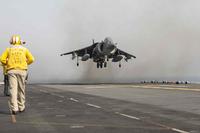The United Kingdom began its hunt for military savings the weekend after the Farnborough Air Show and the search has ranged throughout the defense establishment. The tone was set by Liam Fox, defense minister, when he told the British press: "The current defense programs are entirely unaffordable and the unavoidable reality is that change is coming."
One of Britain's most precious capabilities, the one that gave rise to the famed Special Air Services regiment, is its Long Range Reconnaissance Patrols. Most of this capability resides within the 21 Special Air Services regiment known as the Artists. A Territorial Army unit (roughly equivalent to a reserve unit in the U.S.), the Artists comprises three squadrons, plus an HQ squadron. There are rumors that the British may consolidate one of these squadrons, which happened once before. These special operations units are very expensive, largely because of the training involved, but they have survived since World War II because of the excellent and very flexible capabilities they bring to the British government. They also provide the regular SAS 22 regiment with extra manpower.
Meanwhile, the first full swing of the axe looks to fall on the Air Force, cutting force structure and capability. The Daily Telegraph reports that the cuts will include:
The entire force of 120 GR4 Tornado fighter-bombers looks destined for the scrap heap to save £7.5 billion over the next five years. The Tornado was supposed to be in service until 2025, but with a major overhaul due in the next five years costing £10 million for each aircraft, it is now under threat.The cut will mean job losses as RAF Lossiemouth and RAF Marham totalling almost 5,000 personnel.
Under the plans, the number of Eurofighter Typhoons is likely to be reduced further from 160 to 107 planes based at a single RAF airfield to save £1 billion. The entire fleet of 36 Hercules transport aircraft, the workhorse in Iraq and Afghanistan, is to be phased out and replaced by an order of 22 new A400M planes.
The £3.6 billion project for nine Nimrod MR4 reconnaissance aircraft is also vulnerable, along with a number of other surveillance planes.
The Telegraph reports that the Army could be reduced by as much as 40 percent and the Royal Marines taken from the Royal Navy and grouped with the Army’s two parachute battalions into a super elite unit. One of two Army armored brigades based in Germany will be dropped from the rolls along with its collection of Challenger 2 tanks and Warrior armored personnel carriers.
The paper writes:
“If implemented, the cuts will mean that Britain will almost certainly depart the world stage as a major military power and become what military chiefs call a “medium-scale player.”
On top of all that, the Conservatives who lead the government appear to be skeptical of an innovative set of deals called private finance initiatives. These deals include their CSAR and airborne tanker programs, according to the Telegraph.
Those which could be most vulnerable to cuts are the £13.8bn defence training academy; a £7bn programme to replace search-and-rescue helicopters, which has already been put under review; and a £10bn contract for aerial refuelling planes.
No final decisions have been made and some of this may have been leaked to mobilize public and military opinion to help stave them off. The final cuts will be announced in October. But remember Fox's comments at Farnborough. We may well be witnessing the second major decline in British military capability since World War II.








